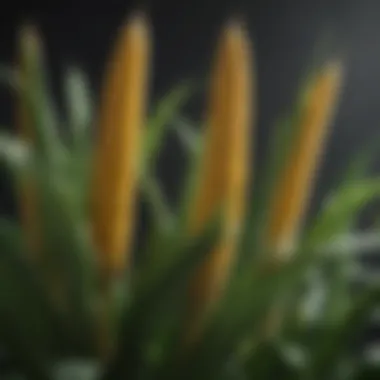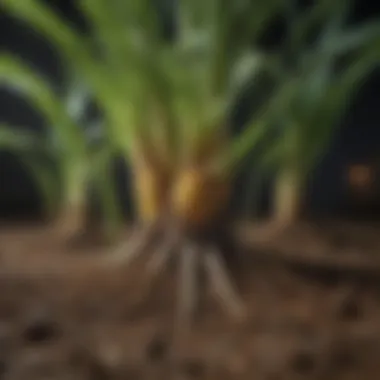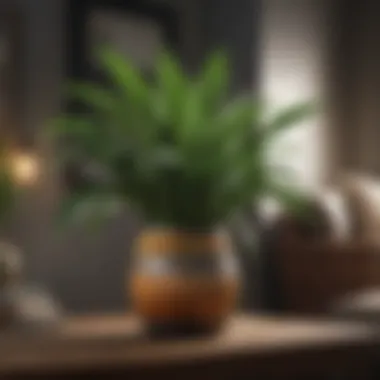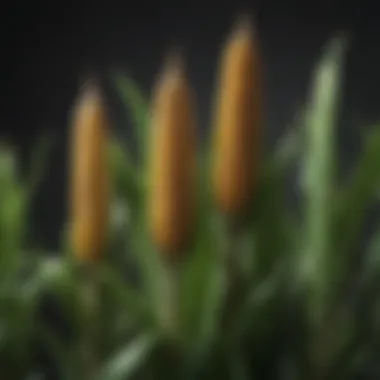Discovering the Corn Plant at Lowe's: Care and Benefits


Intro
The corn plant, or Dracaena fragrans, has gained significant popularity among homeowners and gardening enthusiasts alike. This houseplant is not only appealing but also versatile, fitting seamlessly into a variety of interior spaces. At Lowe's, the corn plant is readily available, allowing both novice and experienced plant owners to explore its unique features and benefits. Understanding its origins, care needs, and potential challenges can greatly enhance the experience of incorporating this plant into your home.
The corn plant is known for its long, arching leaves which can grow several feet high. Its lush foliage can add a touch of greenery that brightens indoor environments. Additionally, the corn plant is recognized for its air-purifying qualities, making it a beneficial addition to any living space. This article will guide you through various aspects of caring for and maintaining a corn plant, while also providing practical purchasing tips at Lowe's.
Design Inspiration
Current Interior Design Trends
In 2023, interior design trends emphasize creating serene and inviting spaces with natural elements. Houseplants like the corn plant are perfect for this aesthetic. Whether it's minimalism, bohemian styles, or modern urban looks, the corn plant complements a range of design philosophies. The natural curves and soft lines of its leaves can contrast beautifully against sleek furniture or a stark color palette.
Color Palettes and Their Effects
Incorporating a corn plant into your decor can also influence the overall color scheme of a room. It pairs well with:
- Neutral tones: Beige, gray, and white can amplify its green hues and create a calm ambiance.
- Bold contrasts: Darker furniture and accents can highlight the plant's vibrancy, adding depth and interest.
- Earthy colors: Shades like terracotta and olive green enhance the organic feel, making spaces feel more connected to nature.
Integrating the corn plant in different rooms will lend each area a fresh vibe, while still keeping with current design trends. The plant’s adaptability allows it to shine in various settings, whether placed in a bright sunlit area or a shaded corner.
"The right plants can elevate a home’s aesthetic, bringing life and tranquility together."
The corn plant, with its elegant appearance, serves as a perfect candidate for these design concepts. By merely placing it thoughtfully in your home, you can achieve both style and environmental benefits.
Prolusion to the Corn Plant
The corn plant, also known as Dracaena fragrans, holds significant relevance for both houseplant enthusiasts and interior design aficionados. This robust houseplant is admired not just for its attractiveness but also for its adaptability to various indoor environments. Understanding the corn plant's characteristics and requirements is key to ensuring it thrives within a home setting.
In this section, we explore the essential facts about the corn plant. You will learn about its common names, scientific classification, and its intriguing historical context. Recognizing these elements will help you appreciate the plant’s significance and unique qualities.
Common Names and Scientific Classification
The corn plant is commonly referred to as Dracaena fragrans. In addition to this scientific name, it has various common names which differ regionally. For example, it is sometimes called the corn tree, simply corn plant, or the tropical plant. Its name is derived from the plant's resemblance to corn stalks.
From a taxonomical perspective, the corn plant belongs to the Asparagaceae family. The genus it is part of, Dracaena, includes over a hundred species. These aspects of classification help in understanding its botanical traits and care needs. Knowing the scientific classification of a plant can aid in research and proper maintenance as well.
Historical Context and Origin
The origins of the corn plant can be traced back to tropical Africa but it has since been cultivated globally, particularly in the Pacific Islands. It was introduced to the United States in the early 20th century and quickly gained popularity as a houseplant. The plant was favored for its ability to adapt to indoor environments, making it ideal for homeowners with modest lighting conditions.
Understanding the background of the corn plant enriches one's appreciation for it. It offers insights into its resilience and adaptability. This historical context also serves to highlight its journey and establishment as a household favorite over time.
Characteristics of the Corn Plant
Understanding the characteristics of the corn plant is essential for anyone considering adding this indoor greenery to their space. The physical features contribute significantly to both its appeal and care requirements. Knowledge of details such as leaf structure, growth habit, and dimensions not only influences purchasing decisions but also plays a key role in proper maintenance and placement within the home.


Physical Features
Leaf Structure
The leaf structure of the corn plant, characterized by long, arching leaves, is a defining feature. These leaves can grow up to three feet long, with a rich green color and often variegated patterns depending on the cultivar. This aesthetic characteristic makes the corn plant a popular choice for interior design. Additionally, the leaf structure is beneficial for air purification, contributing to improved indoor air quality. However, one should be cautious of the leaves' tendency to become brown-tipped under improper watering conditions, which may detract from its beauty.
Growth Habit
The corn plant exhibits a unique growth habit. It grows upright with a central stem that can reach notable heights over time. This vertical growth makes it suitable for small spaces, as it does not require extensive horizontal space. Its ability to adapt to indoor environments enhances its appeal among homeowners looking for decorative plants. Still, it is important to rotate the plant occasionally for even light exposure; otherwise, it may lean toward the light source, which could affect its overall posture.
Height and Width
The height and width of the corn plant can vary, but typically, it achieves heights from four to six feet when fully mature. Its width generally ranges from two to four feet, making it a substantial addition to any room. This size points to its capacity to be a focal point in a room without overwhelming the space. Potential drawbacks include the need for larger pots and a preference for corner placements, as they do not thrive well in crowded environments.
Growth Zones
Hardiness Zones
Corn plants thrive in USDA Hardiness Zones 10 to 12, indicating their suitability for warm indoor conditions. This characteristic reveals that they prefer temperatures ranging from 65 to 75 degrees Fahrenheit. As a houseplant, this trait is particularly advantageous, as it requires minimal effort to maintain the right environment. However, exposure to sudden drafts or extreme cold can lead to stress, making it essential for caretakers to ensure a consistent climate.
Optimal Conditions
For optimal growth, corn plants require bright, indirect light, which enhances leaf coloration. They can tolerate lower light conditions but may grow slower and become leggy. It is important to note that sudden exposure to direct sunlight can cause leaf scorch. Proper watering routines, allowing the soil to dry out between waterings, further support their health. Overall, understanding these optimal conditions helps plant owners create a nurturing environment, ensuring their corn plants flourish.
Purchasing Corn Plants at Lowe's
The act of purchasing corn plants at Lowe's is fundamental for those looking to add a new element to their home environment. This plant, scientifically known as Dracaena fragrans, is celebrated for its resilience and aesthetic appeal. When considering such a purchase, one should be informed about the types available, pricing structures and size options. Understanding these elements ensures that both novice and seasoned plant enthusiasts can make educated choices that align with their gardening aspirations.
Types Available
Standard Corn Plant
The Standard Corn Plant is a prevalent option among consumers. Its easy care requirements and striking appearance make it a favorite for many homeowners. The key characteristic of this plant is its upright growth habit, which can reach impressive heights. Additionally, the glossy green leaves create a sense of tranquility in any living space.
A unique feature of the Standard Corn Plant is its air purifying qualities. It can effectively remove toxins from the air, which makes it a great choice for improving indoor air quality. However, potential purchasers should be aware that it can become quite large if not properly managed. Regular pruning may be necessary to maintain its size within desired limits.
Variegated Varieties
Variegated Corn Plants offer an interesting twist for those who desire something visually unique. These varieties feature leaves that are marbled with shades of cream or yellow along the edges. This characteristic can add visual interest to any interior design scheme. Their distinct appearance makes them an inviting choice for decorators and plant enthusiasts alike.
The advantage of selecting a Variegated Variety lies in its striking color contrast. It stands out in a room and can complement various color themes. However, these plants may require more attention in terms of light exposure to maintain their vibrant foliage. Buyers should consider the specific needs of these varieties to ensure long-term satisfaction.
Pricing and Size Options
Prices for corn plants at Lowe's can differ based on factors such as variety, size, and potting. Generally, you will find options ranging from small starter plants to larger, fully developed specimens.
- Small plants may start at an affordable price, appealing for those who wish to try their hand at caring for this species.
- Medium-sized plants often strike a balance between affordability and instant gratification, offering established growth without a substantial financial commitment.
- Large specimens can represent a bit of an investment, but they also provide immediate impact in terms of decor.


Ultimately, selecting the right size should align with both your space and budget considerations. With a wide range of options available, Lowe's is well-equipped to help you find the perfect corn plant to enhance your living space.
Caring for the Corn Plant
Caring for the corn plant is fundamental to ensuring its health and longevity. Dracaena fragrans, commonly known for its tall and striking appearances, requires specific attention to thrive in a home setting. Recognizing the plant's needs—especially in terms of watering, lighting, soil health, and atmospheric conditions—can make a significant difference in your gardening experience. Adequate care can help prevent common issues and ensure your corn plant flourishes, enhancing your living space.
Watering Guidelines
Watering is essential for any plant's health, and the corn plant is no different. It is vital to maintain a consistent schedule without overwatering. The general guideline is to allow the top inch of soil to dry out between waterings. Overwatering can lead to root rot, while underwatering might cause the leaves to wilt. Therefore, the balance is crucial. Observing the plant regularly can provide cues on when to water. Your corn plant may show signs of distress, such as yellowing leaves or dropping foliage, which point to potential watering issues.
Lighting Requirements
Lighting conditions play a pivotal role in the health of your corn plant.
Indirect vs. Direct Sunlight
Corn plants thrive best in indirect sunlight. Direct sun can scorch their leaves and lead to discoloration. Indirect sunlight, on the other hand, provides the right amount of brightness without overwhelming the plant. This preference makes indirect light a popular choice among indoor plant enthusiasts. It allows the corn plant to grow steadily while maintaining its lush appearance. Ensure your corn plant is placed near a window that provides filtered light, such as through sheer curtains, to keep it healthy and vibrant.
Soil and Fertilization
Soil health is another crucial aspect of caring for corn plants. Proper soil ensures that essential nutrients are available, and sufficient drainage prevents harmful water retention that can damage the roots.
Soil Mixture Suggestions
A well-draining potting mix is essential. A mix of standard potting soil with perlite or sand works well as it facilitates drainage while retaining moisture. A common characteristic of a good soil mixture is its ability to hold enough water without becoming waterlogged. Using a commercial potting mix designed for indoor plants can be beneficial, as it generally contains the right blend of nutrients. However, be cautious of mixes that retain excessive moisture, which can be detrimental to your corn plant.
Fertilizer Recommendations
Fertilization aids in the plant's overall growth and health. A balanced, water-soluble fertilizer can be applied once a month during the growing season. The key characteristic of this fertilization method is its effectiveness in providing a steady supply of nutrients. Additionally, organic fertilizers can enhance soil quality. One must be cautious not to over-fertilize, as this can lead to salt buildup and harm the roots. A well-timed approach to fertilizing your corn plant will ensure it receives optimal nutrition without the risk of damage.
Temperature and Humidity Needs
Temperature and humidity are critical to the well-being of the corn plant. Ideally, it prefers temperatures between 65°F to 80°F (18°C to 27°C). Corn plants are sensitive to extreme cold or hot drafts, which can cause stress. Maintaining humidity levels around 40-60% helps the plant to thrive, particularly in drier climates or during winter months. Regular misting can help achieve these humidity levels, which can be essential for the overall health of your corn plant.
Common Issues with Corn Plants
Understanding the common issues that can affect corn plants is essential for both novice and seasoned gardeners. By being aware of potential problems, you can act proactively to minimize stress on your plants. Addressing these concerns can increase the chances of healthy growth and vibrant foliage. The most common issues include pest infestations, diseases, and environmental stress factors, each of which can have distinct symptoms and solutions.
Pest Infestations
Identifying Common Pests
Identifying common pests that target corn plants is crucial. Common pests include spider mites, aphids, and mealybugs, each with specific telltale signs. For instance, spider mites leave fine webbing and cause stippling on leaves, while aphids can be spotted on the undersides of leaves and may lead to leaf curling. Recognizing these pests allows you to intervene before they cause significant damage. Their detection ensures a quicker response, which is vital for maintaining plant health.
Treatment Options
When it comes to treatment options for pest infestations, several methods can be effective. You can use insecticidal soap or neem oil as eco-friendly choices. Both products disrupt the life cycle of pests and are less harmful to beneficial insects. Regularly checking plants for pests and treating them quickly helps prevent infestations from spreading. The unique aspect of these treatments is their ability to be used without harsh chemicals, aligning with a more sustainable gardening practices.


Diseases and Fungal Problems
Diseases and fungal issues are also common problems for corn plants. Symptoms might include yellowing leaves or black spots, which can indicate fungal infections. A common disease is leaf spot, caused by a fungus that thrives in humid conditions. Timely identification and treatment, often including the removal of affected foliage, can significantly mitigate the impact of these diseases. Maintaining proper air circulation and avoiding overhead watering can also help prevent these issues.
Environmental Stress Factors
Overwatering and Underwatering
Overwatering and underwatering are critical to understand. Overwatering can lead to root rot, while underwatering can cause wilting. Recognizing the balance is vital for the corn plant's health. Signs of overwatering include yellowing and mushy roots, while underwatering will manifest as dry, crispy leaves. Being aware of your plant’s watering needs can prevent these common pitfalls, supporting better overall growth and vitality.
Temperature Stress
Temperature stress is another factor to be aware of. Corn plants thrive in temperatures between 65°F and 80°F. Temperatures outside this range can lead to leaf drop or stunted growth. Recognizing symptoms and adjusting the plant's environment will help mitigate stress. Placing the plant in an area away from drafts or heat sources can help maintain its preferred conditions.
In summary, understanding common issues with corn plants enriches your gardening experience. Being proactive in identifying and addressing these concerns is essential for ensuring healthy, thriving plants.
Benefits of Keeping a Corn Plant
The corn plant, known scientifically as Dracaena fragrans, offers numerous benefits that extend beyond mere aesthetics. Integrating this houseplant into your environment can positively impact both the physical space and the inhabitants within it. Understanding these benefits allows homeowners and gardening enthusiasts to appreciate the value this plant brings to their lives.
Air Purification Qualities
One of the most significant advantages of the corn plant is its air purification abilities. Research has shown that Dracaena fragrans can effectively remove toxins from the air, such as formaldehyde, benzene, and trichloroethylene. These substances often exist in indoor environments due to everyday household products like paints, varnishes, and cleaning agents.
- Mechanism: The plant's leaves absorb these harmful compounds and convert them into harmless substances. This process not only cleans the air but also contributes to a healthier living space.
- NASA Study: According to a study by NASA, the corn plant is among the top plants for improving indoor air quality. Incorporating one or more of these plants can significantly enhance air quality in homes and offices.
"Houseplants improve indoor air quality by removing pollutants and providing oxygen, benefitting both mental and physical health."
Moreover, the presence of greenery can elevate mood and reduce stress levels. This effect is especially important in urban environments where nature might be less accessible. By bringing a corn plant into your home, you invite a touch of nature that contributes to well-being.
Aesthetic Contributions to Interior Design
Apart from its health benefits, the corn plant contributes significantly to interior design. Its tall and stately appearance adds a vertical element to spaces, making it ideal for corners or areas where you want to draw the eye upward.
- Variety in Decor: Available in standard and variegated forms, the corn plant can complement various styles, whether modern, traditional, or eclectic.
- Versatile Placement: It can be placed in numerous settings, from living rooms to offices, creating a sense of harmony and balance. The plant's green leaves offer a refreshing contrast to other decor elements, enhancing overall aesthetics.
- Low Maintenance: The corn plant is relatively low maintenance, making it suitable for both beginners and experienced plant enthusiasts. It adapts well to different lighting conditions and requires minimal care, allowing people to enjoy its beauty without much effort.
In summary, keeping a corn plant offers substantial benefits. Its air purification qualities and aesthetic contributions make it an ideal choice for anyone wanting to improve their living space. Whether you're a homeowner, a design enthusiast, or simply someone looking for a pleasing houseplant, the corn plant serves multiple purposes while enhancing your environment.
Epilogue
The conclusion section serves as a pivotal point in this article, encapsulating the extensive information presented throughout. In considering the corn plant, particularly Dracaena fragrans, its role transcends mere aesthetics; it intertwines with home environment quality, mental wellness, and personal satisfaction in caring for a living entity.
Summary of Key Insights
Throughout the article, various aspects of the corn plant have been explored. The historical significance of its origins provides a context for its importance in both domestic and industrial applications. The diverse characteristics of the corn plant, such as its physical features and growth requirements, invite both novice and seasoned plant owners to engage deeply with their care. Additionally, the issues related to pests and diseases point towards a need for diligence and preparation.
The benefits discussed highlight the corn plant's ability to purify air and its contribution to enriching interior design. These qualities make it a suitable addition for various living spaces, ranging from home offices to vibrant living rooms. Informing readers about the range of products available at Lowe's can streamline the purchasing process, ensuring they find a plant that resonates with their individual preferences and lifestyle.
Encouragement for Gardening Enthusiasts
For those embarking on the journey of caring for a corn plant, it is essential to approach gardening as both a science and an art. Embrace the learning process, and do not shy away from experimenting with different care techniques. Understanding the plant's needs in terms of light, water, and soil composition will lead to a rewarding experience.
Join communities on platforms like reddit.com or local gardening groups on facebook.com to share experiences and gather tips from fellow plant enthusiasts. This collaborative learning enhances the joy of gardening and fosters a deeper connection with your surroundings. The corn plant is not just a decorative feature; it becomes part of your daily life, reflecting your dedication and care. Take pride in the growth and vitality of your plants, and allow them to guide you in becoming a confident gardener.















